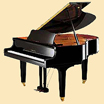| ACTION
The moving parts of the piano, from the key sticks and key
frame to the hammers. Action parts wear out with use, but
generally can be replaced, even in pianos out of production.
CONSOLE PIANO
Consoles are usually 40" to 43" tall, and generally
the choice for home use. Varied cabinet styles and finishes
allow the buyer leeway in matching the room decor.
EQUAL TEMPERAMENT
Tuning scheme whereby the octave is divided into 12 equal
parts, allowing transposition among keys.
GRAND AND BABY GRAND PIANO
Pianos in which the strings run horizontally. They come in
varying sizes from 4' 10" (apartment size) to 9' (Concert
Grand size)
MICROGRAND
A category of inexpensive, petite grand pianos usually less
than 4'10" long. These are more to look at than to play.
Some have recently been discontinued by domestic manufacturers.
REGULATING
Adjusting the Action to make everything work properly. If
it is to continue to play and feel the same way it did when
it was new, the pianos Action must be "timed" accurately
- and not in just one key but in all eighty-eight. Your piano
technician will let you know when this is necessary.
REPETITION
Ability of a piano or keyboard to play successive notes rapidly,
without the key actually returning to rest between strokes.
SOUNDBOARD
A large wooden diaphragm which is forced to vibrate by the
strings, increasing their loudness.
SPINET PIANO
Generally around 36” tall, spinets are the shortest style
of piano made today. To achieve the low height, compromises
in design are necessary which impair their tone and touch.
For these reasons, spinets have mostly fallen out of favor
with the public, however they are still being made by a few
manufacturers. Spinets feature the "drop action",
not a favorite among technicians.
STEINWAY
Steinway and Sons of New York and Hamburg, a widely used brand
of concert pianos. It has always been considered a premier
instrument.
STUDIO PIANO
Being 43" to 47" high, the studio benefits from
a larger soundboard and longer strings, which usually result
in a better tone. Cabinet styles have simpler lines, in keeping
with school, church or institution traditions. These usually
cost more than a console or spinet, but are often well worth
the difference.
TOUCHWEIGHT
Force required to depress a piano key to the point of let-off,
with the damper pedal depressed.
UPRIGHT PIANO
Uprights are 48" to 60" tall, and passed their heyday
around 1925. They have always been popular because of their
depth and richness of tone. They are still made today, and
while somewhat expensive, most are excellent instruments.
VERTICAL
A piano in which the strings and soundboard are vertical as
opposed to grand pianos where the strings run horizontally.
VOICING OR TONE REGULATING
The delicate art of altering and leveling up tonal response
by adjusting the compression of the hammer head felts. This
procedure will restore the proper power and quality of the
tone to the piano.
|

